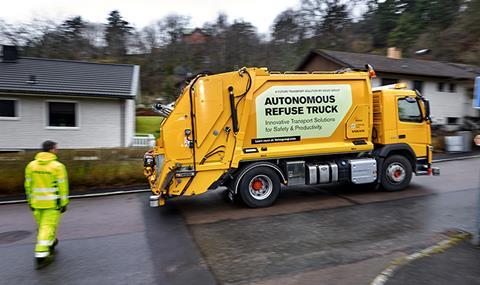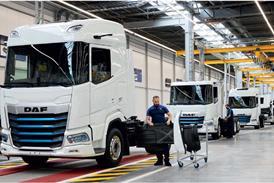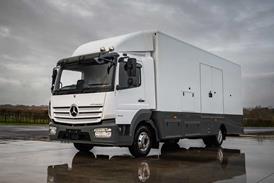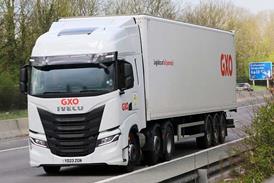
Volvo Group debuted a self-driving FM refuse truck at its UK Innovation Summit this week, to demonstrate the potential safety and environmental benefits for urban areas.
The concept truck has been developed and tested over the past two years in collaboration with Swedish waste and recycling firm Renova.
Volvo Group chief technology officer Lars Stenqvist said: “There is amazing potential to transform the swift pace of technical developments in automation into practical benefits for customers and, more broadly, society in general.
“Our self-driving refuse truck is leading the way in this field globally, and one of several exciting autonomous innovations we are working with.”
How does it work?
The first time the automated refuse truck is used in a location, it is driven manually while the on-board system monitors and maps the route with the help of sensors and GPS. Upon entering the area a second time, it knows exactly which route to follow and at which bins it has to stop.
At the first stop, with the automated system activated, the driver climbs out of the cab, goes to the rear of the truck, brings out the wheelie-bin and empties it as normal. When the operation is completed, the truck automatically reverses to the next bin upon the driver’s command.
The driver walks the same route as the truck to have a full view of what is happening in the direction of travel.
Reversing, rather than driving forwards, enables the driver to remain closer to the compactor during collections.
“And since the driver doesn't have to climb in and out of the cab at every start and stop, there is less risk of work-related injuries such as strain on the knees and other joints," said Hans Zachrisson, strategic development manager, Renova.
Volvo said the self-driving truck aims to reduce the risks associated with reversing an HGV in urban areas, even when fitted with cameras.
Sensors continuously monitor the vehicle’s vicinity and the truck stops immediately if an obstacle suddenly appears in its path, or if the driver activates the emergency stop function.
It also has potential for lowering fuel consumption and emissions, as gear changes, steering and speed are constantly optimised.
https://www.youtube.com/watch?v=zJSHXr8i-ZU
Timeframe
The joint research project with Renova will continue until the end of 2017 and will be followed by an evaluation of functionality, safety and the acceptance of drivers, road users and residents.
However, the manufacturer said a lot more R&D work remains before self-driving refuse trucks will become a reality on our roads.
Instead, it believes varying degrees of automation will probably be introduced earlier in other applications, where transport operations take place within strictly confined areas.
For example, the technology used in the refuse lorry research is also being used in a trial of a self-driving truck for mining operations in the Kristineberg Mine in northern Sweden.
Volvo Group demonstrated the truck in action yesterday at its Innovation Summit in London, where it also brought its fully-electric passenger bus and the world's first zero-emission, near-silent, all-electric excavator aimed at urban construction sites.













